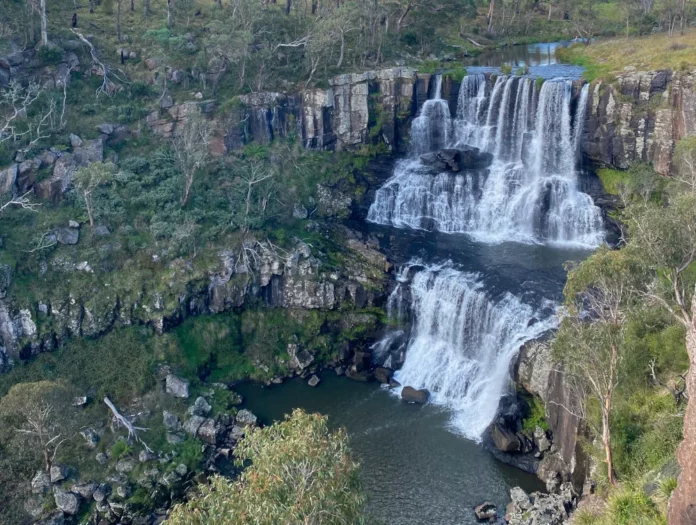Travelling North from Sydney towards Queensland, the Inland route by train or car takes you through Armidale, seat of the evangelical diocese of the same name, and the coastal route takes you through Grafton, the cathedral city of a progressive diocese.
The border roughly runs along the appropriately named Great Dividing Range, appropriately named because these two dioceses or regions represent the division in The Australian Church. You can travel between them via the picturesque “waterfall way” – our picture shows the Ebor Falls.
A dispute at the small St Mary’s Church in West Armidale, where a married gay couple was told they could not hold leadership roles in the parish and be in their relationship by their evangelical Bishop Rod Chiswell, made a splash in the Weekend Australian magazine and then other media outlets in 2021. Peter Grace and Peter Sanders had been married civilly in Coffs Harbor, coincidently over the range in the Grafton Diocese.
By contrast, in Grafton, an unreported story has seen the exodus of evangelical clergy following a bishop’s election. An increasing number of evangelicals had scared the progressive majority into thinking they had to bar the door. Many evangelical ministers now see Grafton as a place where it is hard for them to serve.
Critics of Armidale will point to the 1960s when an evangelical bishop, Clive Kerle, was elected, and the diocese steadily moved evangelical.
A couple of weeks ago, I visited St Peters’s Cathedral in Armidale. There were candles on the holy table, and the sacristy lamp was burning – six decades after Kerle was elected. I would not expect to see either of these things in a mainstream Sydney Anglican Church – I took it to mean that the evangelicals of Armidale are trying to be as gentle to parishioners who are more Anglo-Catholic. But overall, the impression I gained was of a diocese now happily evangelical.
This sets up today’s situation where a resolutely evangelical Armidale sits on the NSW tablelands, and an equally resolutely progressive Grafton is on the lush green coast. In years to come, the effectiveness of each type of Anglicanism will be tested.
Grafton’s NCLS results show an average age of attendees of 73. There were 111,737 attendances at churches in Grafton in 2022, down from 181,121 in 2019. The average Sunday attendance is 2149. In his 2019 presidential address, Grafton’s Bishop Murray Harvey acknowledged that “Total attendance on an Average Sunday in our Diocese was 3,305 in 2006. By 2011, it was only 2370.”
I have been unable to source up-to-date figures for Armidale.
The only figures I have that directly compare the two dioceses come from the 2014 viability study for the Anglican General Synod. Armidale indicated an attendance of 3685, and Grafton the 2370 mentioned by Bishop Harvey.
If we assume that both dioceses have maintained roughly their 2014 attendance or a light decline, as indicated by Grafton, it might be possible to declare them equally viable. There are good signs that Armidale may be growing – such as the placement of five curates expected in 2024—but on the other hand, it was drought-affected in earlier years.
However, the big picture shows Armidale covering an inland area with towns growing slowly. Armidale city experienced a 1 per cent population increase while some other smaller towns declined. Grafton, as a coastal region, has seen major growth, especially in places like Coffs Harbor and Port Macquarie, unlike inland Armidale.
In 2011, Grafton diocese’s population was 463077; in 2021, 523661 (a 13 per cent increase). In 2011, the Armidale diocese’s population was 187491; and in 2021, 190642 (a 4 per cent increase).
Perhaps more tellingly, when considering the percentage of the population attending church, the viability report put Armidale well ahead of Grafton: 2.01 and 0.511 per cent of the population, respectively. And that’s before taking into account the increase in the coastal population since and the withdrawal of some evangelicals from the diocese.
Image: The Ebor Falls, Waterfall Way, NSW
Updated: to make it clear, Bishop Harvey is from Grafton and his numbers reflect that diocese.










